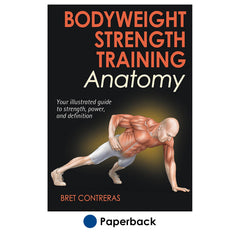Glutes in Motion
This is an excerpt from Bodyweight Strength Training Anatomy by Bret Contreras.
Glutes in Motion
The glutes are vital for functional movement. Walking, standing up from a chair, climbing stairs, picking up objects off the floor, and carrying objects across the room all require properly functioning posterior chain musculature. (The spinal erectors, gluteus maximus, and hamstrings make up the posterior chain.) The gluteus maximus plays a major role in most athletic activities. As an athlete matures from novice to advanced to elite status, he or she learns to derive increasing amounts of propulsive power from the hips. Propulsive power is considerably influenced by the strength of the gluteus maximus because this muscle is heavily involved in nearly all primary sporting motions including running, cutting, jumping, throwing, and striking.
The gluteus maximus contracts forcefully to extend the hips during foot strike in a sprint, during a countermovement vertical jump, while freestyle swimming or hiking a mountain, and to buck an opponent out of a full-mount position in mixed martial arts. The external rotational power of the gluteus maximus produces the twisting torque at the hips required to forcefully swing a bat in baseball or softball or racket in tennis, to throw a ball in American football or baseball, to heave a shot put, discuss, or hammer in track and field, or to throw a hook, cross, or uppercut in boxing. The abduction power of the gluteus maximus produces lateral stability during running to prevent hip sag in addition to producing lateral power when cutting from side to side during agility and change-of-direction maneuvers in sports such as American football, soccer, volleyball, basketball, hockey, and tennis.
Not only is the gluteus maximus involved in high-power and speed sports such as track and field, it also is used in high-force sports such as powerlifting and strongman. Heavy squatting, deadlifting, stone lifting, and carrying require intense gluteus maximus strength. In Olympic weightlifting, cleaning, jerking, and snatching actions require substantial gluteus maximus power to accelerate the barbell.
What's more, the gluteus maximus functions concentrically, eccentrically, and isometrically during sporting actions to produce and reduce force. It also prevents energy leaks, which maximizes movement efficiency. Sure, sporting movement requires that your muscles work in a coordinated and synergistic fashion. And yes, many muscles are important for producing power and speed, such as the quadriceps during jumping and the hamstrings during sprint running. That said, an excellent case could be made that the gluteus maximus is the most versatile and important muscle for total athleticism because of its multiple functions at the hips.
Bodyweight exercises can build the glutes very well, but it's important to first learn proper form during basic exercises before advancing to more difficult variations. Many people fail to properly activate their glutes or use movement strategies to take advantage of the strong and powerful gluteus maximus. By mastering proper activation and using excellent technical form, you will rely on the gluteus maximus for many primal movement patterns, including squatting, bending, lunging, twisting, walking, and running. It is often said that abs are made in the kitchen. I'm here to tell you that glutes are made during strength training exercise.
Learn more about Bodyweight Strength Training Anatomy.
More Excerpts From Bodyweight Strength Training Anatomy

Get the latest insights with regular newsletters, plus periodic product information and special insider offers.
JOIN NOW
Latest Posts
- What performance obstacles do master athletes face?
- Cannabidiol (CBD) and mycoprotein as supplements
- Weight, body composition, and performance in athletes
- The gut-brain-bone axis and Biodynamic Skeletal Therapy
- Touch-testing in Biodynamic Skeletal Therapy treatment
- The six stages of Biodynamic Skeletal Therapy treatment


